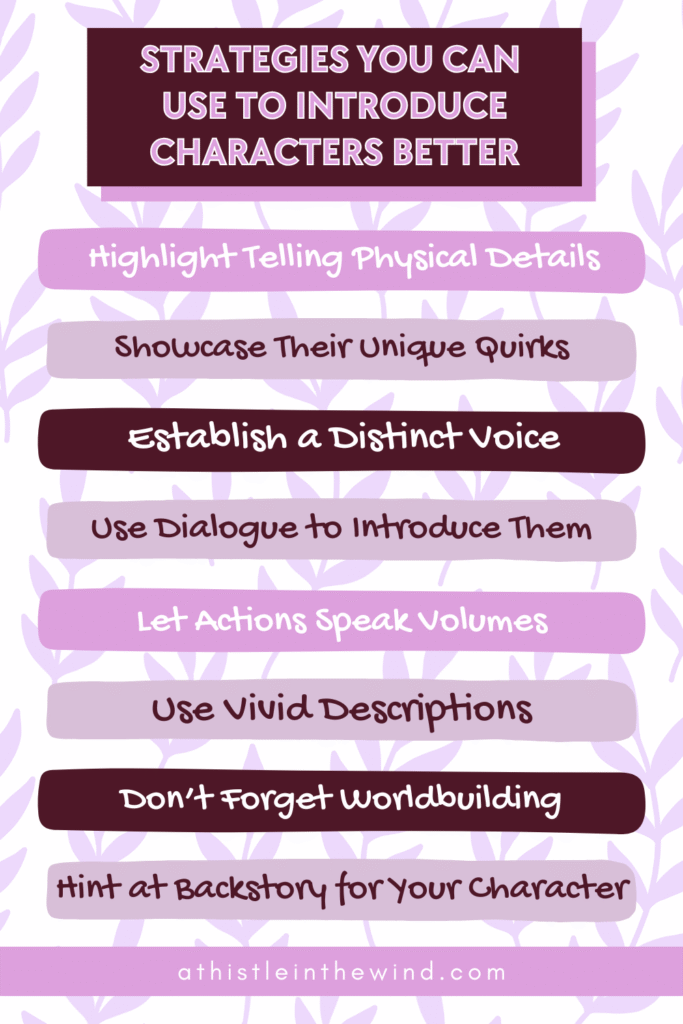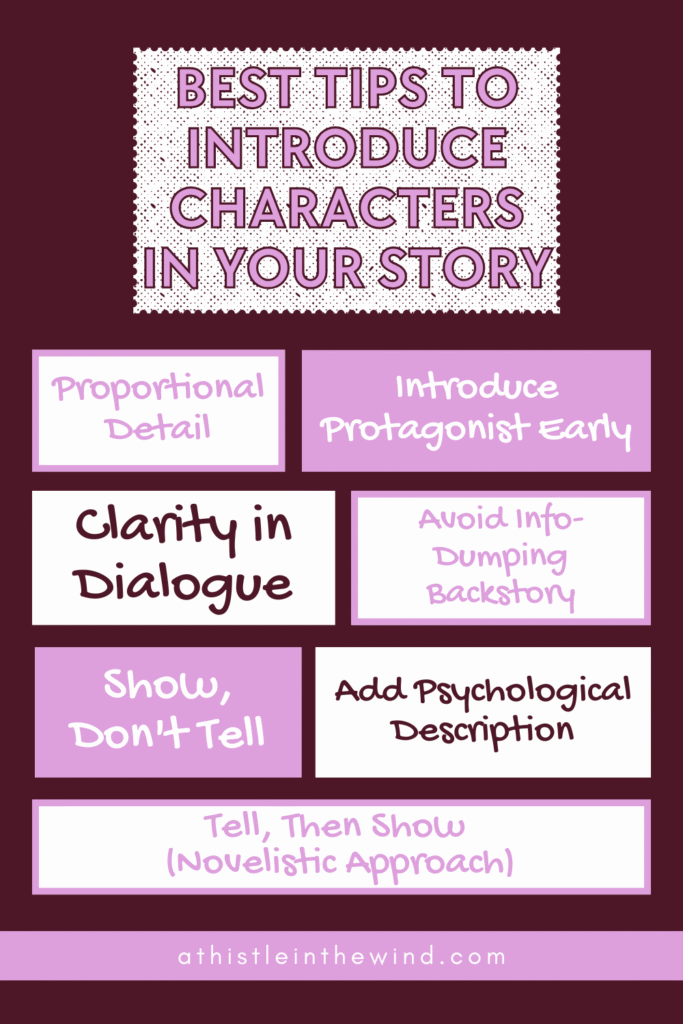On Writing Unforgettable First Impressions: Your Guide to Introducing Characters

Let’s be honest, characters are the beating heart of any story. In fact, writers spend a lot of hours developing their personalities, their motivations, their desires and so on. And that’s great; you should probably know what your characters’ roles will be in your story. But once you’ve figured that out, the crucial next step is to introduce your characters in a way that captivates your audience. From the very first encounter.
It doesn’t have to be fantastical. It just needs to be right. Because here’s the thing: just as in real life, first impressions are everything in fiction.
A strong character introduction will not only hook readers but also make them desperate to learn more about them.
Of course, there isn’t a single magic formula for introducing a character. Every story does it differently. However, there are numerous effective techniques and guidelines you can employ to make your characters leap off the page.
Strategies for Introducing Characters Effectively
When you first introduce characters in a book or story, your primary goal should be to spark interest and forge an immediate connection. This ensures readers are keen to continue reading and get to know them better.
1. Highlight a Few Telling Physical Details
One of the most straightforward ways to introduce a character is through their physical appearance. However, the key here isn’t to provide an exhaustive list of every detail, but rather to select a few distinct, telling physical traits that will resonate with the reader and stick in their mind. Instead of overwhelming them, you offer touchpoints that allow their imagination to fill in the rest.
Consider Amy Dunne in Gone Girl: her fine-boned, “china doll” face and corn-silk hair instantly suggest something delicate and controlled. In contrast, Katniss Everdeen in The Hunger Games is introduced with just a few blunt details—her dark braid, lean build, and wary eyes.
These aren’t just descriptions; these carefully chosen traits define characters before they even speak, suggesting there’s more beneath the surface, immediately intriguing the reader. When you introduce a new character, small, evocative details like these can go a long way in drawing readers in.
2. Showcase Their Unique Quirks
Beyond physical appearance, introducing characters through their unique behaviours, or quirks, is a powerful way to make them memorable. A quirk can be anything out of the ordinary – an unusual ritual, a peculiar speech pattern, or even an intense attachment to an object. These distinctive habits signal something about their personality and often hint at their inner workings.
Take L from Death Note. His quirks are iconic: he squats on chairs instead of sitting, constantly bites his nails, holds objects with only two fingers, and prefers being barefoot, even when socially inappropriate.
These habits immediately suggest that L’s mind operates differently, painting him as an eccentric genius unconstrained by social norms, enabling him to approach problems from unique angles. When you introduce a new character in a story, even one or two well-chosen peculiarities can make them unforgettable.
3. Establish a Distinct Voice
A character’s unique voice—how they express their humour, opinions, and worldview—is another excellent method for introducing a character. This goes beyond just dialogue; it includes their internal monologue and the way they perceive and narrate the world around them.
In The Hunger Games, Katniss Everdeen’s narration is direct, unsentimental, and alert. Her voice quickly shows she’s pragmatic and wary, shaped by hardship. When she describes her district or her mother’s depression, her matter-of-fact tone tells us as much about her resilience as it does about her world. This clear, authentic perspective draws readers in from the first page.
4. Use Dialogue
Dialogue is an indispensable tool for characterisation, offering profound insights into a character’s personality and how they interact with the world. The choices they make in communication, their tone, word selection, and manner of speaking, tell the reader a great deal. Nailing those first few lines of dialogue is therefore essential when you introduce characters in a story.
Consider the opening exchange between Clarice Starling and Dr. Lecter in Thomas Harris’s The Silence of the Lambs. Dr. Lecter’s precise, subtly controlling, and menacing dialogue immediately establishes him as intelligent, formidable, and unsettling. Every word he chooses, and how he treats Clarice, creates an atmosphere of unease, compelling readers to learn more.
How Writers Use Dialogues
Skilled authors use dialogue to:
- Show Personality Through Speech Patterns: The tone, word choice, and rhythm of a character’s speech reveal their inner self. For instance, in Losing Juliet by June Taylor, the contrast between one character’s guarded, precise speech and another’s casual, assertive tone instantly defines their personalities and dynamic.
- Reflect Relationships Through Dialogue: How characters speak to one another can subtly convey their relationship dynamics, including past secrets or simmering tensions, making conversations feel rich and layered.
- Reveal Motivation Through Subtext: Great dialogue often hints at deeper fears or uncertainties without explicit exposition. Authors can weave in subtle layers, allowing readers to “read between the lines” to uncover hidden motivations.
- Show Conflict and Tension: Dialogue under pressure can reveal a character’s core traits, vulnerability, and resilience. Conversations highlighting unresolved issues or anger offer glimpses into what drives a character.
- Balance Dialogue with Actions and Reactions: Dialogue is most impactful when complemented by physical cues, gestures, and subtle actions. These details deepen the impact of what is said (or left unsaid), making the interaction feel more real and immersive.
- Reflect Character Growth in Speech: As characters evolve throughout the story, their dialogue should also change, reflecting their journey and development.
Remember, the goal is for dialogue to feel natural. If it sounds stilted or like an “info-dump,” readers will disengage. It doesn’t matter if a character speaks a lot or a little, or uses a specific dialect, all of this contributes to a good character introduction.
If you’re interested in learning more about writing dialogue, check out: On Writing Dialogue: How to Write Better & Believable Lines.
5. Let Actions Speak Volumes
You know the saying: “actions speak louder than words.” This is especially true for when you’re introducing characters in your story. If you want to swiftly establish a character’s personality, introduce them through their actions rather than extensive description.
In F. Scott Fitzgerald’s The Great Gatsby, Gatsby’s first real appearance isn’t marked by lengthy description but by the simple, almost theatrical gesture of raising his glass in a silent salute. That small action—elegant, enigmatic—tells us volumes about his charm and mystery. Similarly, Darth Vader’s introduction in Star Wars: A New Hope—surveying the dead with annoyance and then choking someone—establishes him as a powerful villain before he even utters a word. When introducing a character, showing what they do can be far more impactful than telling who they are.
6. Use Vivid Descriptions
Your choice of adjectives and descriptive language significantly shapes the reader’s initial perception of a character. Well-chosen words can quickly convey a wealth of information about their appearance, personality, and demeanour, making them instantly more memorable.
In Jane Austen’s Pride and Prejudice, Mr. Darcy is first described as “handsome” but with a “proud” and “disdainful” air—adjectives that instantly color the reader’s perception and hint at his social arrogance. Compare that to describing someone as “aloof,” “unapproachable,” or “superior”; each word carries a slightly different shade of meaning and helps you fine-tune the impression you create. Powerful adjectives with clear connotations build a deeper connection and make your characters feel real from their first appearance.
7. Don’t Forget Worldbuilding
When introducing characters, you have a unique opportunity to organically weave in elements of your story’s setting, magic system, or history. Your protagonist serves as the emotional anchor and the reader’s “eyes,” so integrating worldbuilding details into their introduction can hook readers on both the character and the world.
In Philip Pullman’s The Golden Compass, Lyra is introduced sneaking into a forbidden Retiring Room at Jordan College. In just a few paragraphs, readers learn she’s reckless and curious, that this is a world where scholars debate Dust, and that daemon companions are a normal part of life. All these details are revealed naturally through her actions and observations, making the setting feel immersive without heavy exposition. To achieve this, reveal information through your character’s thoughts, dialogue, and choices, so readers learn about the world alongside them.
If you’re interested in learning more about worldbuilding, check out: On Worldbuilding: A Comprehensive Guide.
8. Hint at Backstory
And finally, introducing characters by tapping into their backstory provides context and motivation for their actions, making them more relatable and intriguing. A well-crafted backstory can endear characters to readers.
In Leigh Bardugo’s Shadow and Bone, Alina Starkov’s first chapters hint at her years as an orphan and how she never quite fit in. These small details—her memories of hunger, her bond with Mal—immediately explain her longing for belonging and shape her choices.
You don’t need a full flashback to engage readers. Small glimpses can be just as effective. In John Green’s Looking for Alaska, Miles’s obsession with famous last words subtly hints at his loneliness and desire for meaning, which makes his fascination with Alaska feel natural. When you introduce a character, resist the urge to “info-dump” every detail. Instead, let their past emerge gradually, adding layers as the story unfolds. The introduction is merely the first glimpse.

Special Considerations for First-Person Characters
Introducing first-person characters can be tricky because directly describing their physical appearance can feel clichéd (e.g., “I looked in the mirror…”). Here are some methods specific to this point of view:
- Direct Introduction: The narrator can speak directly to the reader, introducing themselves. While sometimes considered old-fashioned, it can be very effective.
- Introduction to Another Character: The narrator introduces themselves to another character in the story. The risk of “info-dumping” is higher here, so ensure only essential information is conveyed.
- Contrast with Another Character: Introduce the first-person character by contrasting them with someone else. For example, “unlike my diminutive and dainty sister, I was tall and had wide shoulders.” This allows for physical description without feeling forced.
You can also rely on their unique voice and how they describe their surroundings to give readers an idea of their personality and state of mind, without explicitly detailing their appearance.
General Best Practices for Introducing Characters
There are, of course, tried and tested methods that have been used by writers throughout the ages. So, I thought a general best practices list (tell me I’m in product, without telling me I’m in product lol) would work here. So, here you have it:
1. Proportional Detail
The amount of detail you provide when introducing a character should be proportional to their importance in the story. For a main character, you need a name, age, and some description. For a minor, one-off character like a cashier, simply referring to them by their role is sufficient. Avoid lingering on unimportant figures.
2. Introduce Protagonist Early
Your main character should appear in chapter one. This immediately gets the story going and clearly indicates who the reader should be rooting for. If you’re writing romance, both main characters should ideally appear within the first two chapters.
3. Clarity in Dialogue
Especially in the early stages of a story, where readers are still learning the world and its inhabitants, make it clear who is speaking. Use names or simple tags like “John said” to avoid confusion.
4. Avoid Info-Dumping Backstory
While hinting at backstory is powerful, resist the temptation to reveal everything about a character’s past right at the start. You know your characters intimately, but your reader doesn’t need to know every facet of their history at once. Think of it as an iceberg: only show the relevant, visible bits. You can always trickle in more information later, adding layers and depth as the story progresses. A compelling introduction is just the initial glimpse; the reader has the whole book to truly get to know your character.
5. Show, Don’t Tell
This fundamental writing principle applies strongly to character introductions. Instead of stating a character is “brave,” show them performing a courageous act. This allows readers to infer traits from actions and dialogue, making the character feel more real and engaging. This is the most frequent form of character introduction in many successful narratives.
6. Pithy Psychological Description
Some writers master the art of summing up a character’s strengths and weaknesses in a short, impactful sentence. While effective for certain narrative voices, it can feel too self-conscious for others.
7. Tell, Then Show (Novelistic Approach)
Occasionally, a more “novelistic” description that tells us details about a character or their backstory that wouldn’t explicitly be seen on screen can be incredibly powerful. This approach, when beautifully observed, can signal an emotionally truthful character with multiple layers, building confidence in the writer and compelling the reader to continue.

Get Your Character’s Grand Entrance Right!
In the end, I’d say that introducing characters is primarily about making a lasting first impression. And, there are plenty of ways to do it. You can choose to do this through subtle physical cues, an outrageous quirk, their distinct voice, a striking action, or by having their reputation precede them, the goal remains the same: to create an instant hook.
Knowing your character intimately, understanding their strongest traits and deepest flaws, is the foundation. Then, it’s about choosing the most dramatic and revealing way to present them.
By applying these techniques, you can ensure your characters don’t just appear on the page, but rather leap off it, fully formed and ready to draw your readers into their world.
If you’re interested in learning more about writing characters, check out: How to Write More Likeable (or Unlikeable) Book Characters
